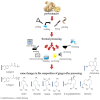Impact of Thermal Processing on the Composition of Secondary Metabolites of Ginger Rhizome-A Review
- PMID: 36360097
- PMCID: PMC9656818
- DOI: 10.3390/foods11213484
Impact of Thermal Processing on the Composition of Secondary Metabolites of Ginger Rhizome-A Review
Abstract
Ginger (Zingiber officinale Rosc.) is both a commonly used spice, and an ingredient of various dietary supplements and medications. Its diverse applications result from the range of health benefits that this plant brings thanks to the presence of active compounds (secondary metabolites) in the matrix. Even if several studies underline a stronger pharmacological activity of fresh ginger rhizomes, the unprocessed plant is relatively rarely used. Ginger rhizomes are subjected to thermal processing, such as boiling, blanching, steam drying and others, at different temperature and time settings. Additionally, freeze-drying of the rhizomes is used as the first step in the preparation of raw material. It was proved that the composition of secondary metabolites of the Zingiber officinale rhizome changes upon the influence of temperature. Therefore, the aim of the review was to put together scientific results on the impact of traditional and unconventional methods of heat treatment on ginger rhizomes and to show the compositional differences that they induce in the plant matrix. Variations in the content and the transformation of some compounds into other metabolites will be also discussed, with particular attention paid to two major groups of secondary metabolites present in the plant, namely, phenolics and terpenes.
Keywords: Zingiber officinale Rosc.; composition; dietary supplements; thermal treatment; transformation of components.
Conflict of interest statement
The authors declare no conflict of interest.
Figures
Similar articles
-
Impact of Thermal Processing on the Selected Biological Activities of Ginger Rhizome-A Review.Molecules. 2023 Jan 3;28(1):412. doi: 10.3390/molecules28010412. Molecules. 2023. PMID: 36615602 Free PMC article. Review.
-
Influence of Diet on the Bioavailability of Active Components from Zingiber officinale Using an In Vitro Digestion Model.Foods. 2023 Oct 24;12(21):3897. doi: 10.3390/foods12213897. Foods. 2023. PMID: 37959015 Free PMC article.
-
Influence of Thermal Processing and in vitro Digestion on the Antioxidant Potential of Ginger and Ginger Containing Products.Nat Prod Commun. 2016 Aug;11(8):1153-1156. Nat Prod Commun. 2016. PMID: 30725579
-
Gamma irradiations induced morphological and biochemical variations in in vitro regenerated ginger (Zingiber officinale rosc.)- an invaluable medicinal spice.Int J Radiat Biol. 2021;97(12):1696-1704. doi: 10.1080/09553002.2021.1988179. Epub 2021 Oct 11. Int J Radiat Biol. 2021. PMID: 34597254
-
In vitro propagation of ginger (Zingiber officinale Rosc.) through direct organogenesis: a review.Pak J Biol Sci. 2013 Dec 15;16(24):1826-35. doi: 10.3923/pjbs.2013.1826.1835. Pak J Biol Sci. 2013. PMID: 24516998 Review.
Cited by
-
The postbiotic potential of Aspergillus oryzae - a narrative review.Front Microbiol. 2024 Oct 23;15:1452725. doi: 10.3389/fmicb.2024.1452725. eCollection 2024. Front Microbiol. 2024. PMID: 39507340 Free PMC article. Review.
-
Impact of Thermal Processing on the Selected Biological Activities of Ginger Rhizome-A Review.Molecules. 2023 Jan 3;28(1):412. doi: 10.3390/molecules28010412. Molecules. 2023. PMID: 36615602 Free PMC article. Review.
-
Ginger Bioactives: A Comprehensive Review of Health Benefits and Potential Food Applications.Antioxidants (Basel). 2023 Nov 18;12(11):2015. doi: 10.3390/antiox12112015. Antioxidants (Basel). 2023. PMID: 38001868 Free PMC article. Review.
-
Effects of Drying Methods on the Phytochemical Contents, Antioxidant Properties, and Anti-Diabetic Activity of Nasturtium officinale R.Br. (Betong Watercress) from Southern Thailand.Life (Basel). 2024 Sep 23;14(9):1204. doi: 10.3390/life14091204. Life (Basel). 2024. PMID: 39337986 Free PMC article.
-
Influence of Diet on the Bioavailability of Active Components from Zingiber officinale Using an In Vitro Digestion Model.Foods. 2023 Oct 24;12(21):3897. doi: 10.3390/foods12213897. Foods. 2023. PMID: 37959015 Free PMC article.
References
Publication types
Grants and funding
LinkOut - more resources
Full Text Sources


